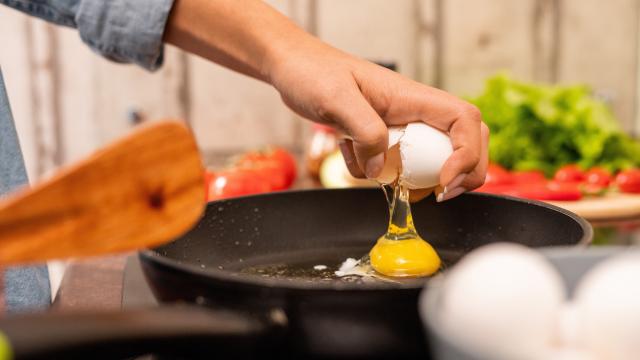As the adage goes, where there’s a will, there’s a way … to fry eggs. But that doesn’t mean it’s gonna be pretty: Some pans are just better for cooking certain styles of eggs than others. Using the right pan can mean the difference between a runny yolk with crispy, lacy edges, or crusted-on, dried-up egg residue laced only with disappointment.
Eggs are notorious for sticking to pans, especially to porous materials like stainless steel and cast iron. The protein-rich ovum hits the material and seeps into the microscopic divots. When they cook, the proteins can bond with the pan. Before you know it, your eggs are stuck. Depending on the type of eggs you want to cook, you might be better off switching out your pan.
The nonstick pan
Frying pans come in a variety of nonstick coatings, with or without Teflon. With just a tiny bit of oil or butter you can add delicate eggs to a non-stick pan with no sticky issues. Non-stick pans are your all-purpose egg pan; able to handle most egg textures and styles, but ideal for tender results and low-heat cooking. Use a nonstick pan for a creamy French scramble, fluffy omelette, an over-easy, or sunny side-up egg that won’t tear open when you scoop it onto your plate.
The stainless steel pan
Not that it’s a beauty contest, but if it was, stainless steel pans would win. Besides being prettier, they can move safely from the stove top to the oven, sear meats beautifully, and can last for decades if well cared for. They are, however feared by many an egg-cooking adult. They’re notorious for bonding with your delicate proteins, and they won’t let go until your breakfast is ruined.
Unless, that is, you heat it up nice and hot first. Before frying your eggs, preheat your skillet until it’s screaming hot. As we explained in this post, heating the pan to the right temperature will ensure a proper barrier of steam and oil can protect your egg proteins from clinging to the metal. With heat this high, it’s easy to get a nice crispy egg white, so embrace fried eggs with this pan. You can also make yourself a scramble, but be attentive: The high temperature will cook your scrambled eggs in mere seconds.
The cast iron skillet
The rugged heavyweight of this crew is the mighty cast iron skillet. There was a time when I would have nervously laughed if someone told me to fry an egg in cast iron. That was before I actually ever owned one. Some of my favorite meals have come out of my trusty Lodge pan—most recently, fried eggs with onions and mushrooms.
Similar to stainless steel, the key to cooking delicate proteins is a protective layer to keep them from sticking. But instead of a temporary steam layer, well-loved cast iron has seasoning—a layer of polymerized oil. It creates a type of non-stick, or low-stick, surface and helps prevent rust.
Cast iron isn’t light by any means, and the surface can be rather rough, so while you might not be able to roll out a slick French omelette with ease, you can make an incredible fried egg with crispy edges and a silky yolk. Since eggs cook quickly, I like to cook the other components of my breakfast in the cast iron first. Crisp up lardons and fry onions and mushrooms in the fat. Scoop those onto a plate and fry your eggs in the flavorful drippings.
The wok
The wok is uniquely defined by its bowl-shaped bottom and tall, flared sides. As it’s known for quick stir-fries and propping up bamboo steamers, you might not associate it with frying eggs but that tapered design gets the job done, and done well.
Using a lot less oil than you would in a frying pan or skillet, you can create a pool of oil in the bottom of a wok and shallow fry an egg straight to heaven. The result is completely different from your average pan-fried egg. The hot oil plunge creates big billows of egg white on top with a crisp bottom. You can leave it sunny and take the egg out once the white sets, or tilt the pan and use a wok spatula to gently toss the hot oil over the top. The hot oil will gently cook the top of the egg while keeping the yolk jammy.
Fried aren’t the only style of eggs you can make in a wok. You can make a lovely kai jiao (a Thai egg dish somewhere in between a fluffy scramble and an omelette, but deep-ish fried) with that small pool of oil. Scrambling eggs is easy in a wok also, because the bowl shape can help you cook the curds faster. Just incorporate a quick swirling motion before you begin mixing them all about. And yes—you can make a filled omelette in a wok, too. As long as the wok is seasoned and you have a bit of oil in there, the curved surface will have your breakfast ready in record time.

Leave a Reply
You must be logged in to post a comment.